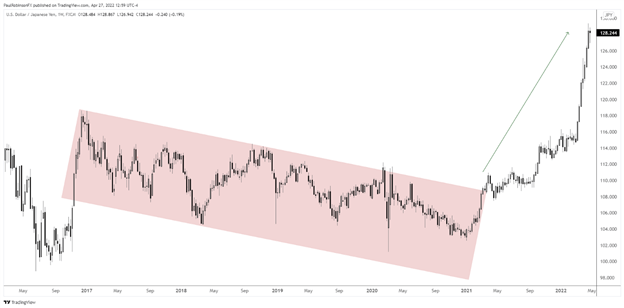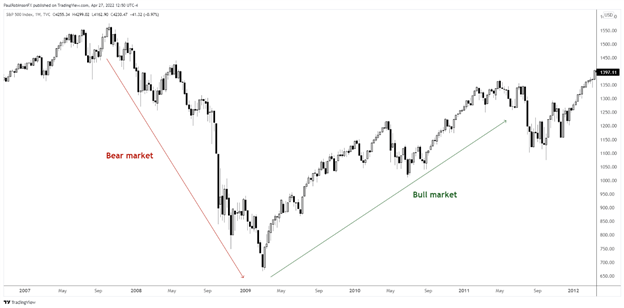Why do trends in markets form?Technical analysis is often a misunderstood discipline, and even misrepresented by some of its biggest proponents. Tech
Why do trends in markets form?
Technical analysis is often a misunderstood discipline, and even misrepresented by some of its biggest proponents. Technical analysis doesn’t so much drive the market (although there is an element of technically-driven trading occurring), but is a way to analyze market participants’ collective perception of the underlying fundamental drivers and catalysts, or fundamental theme when one develops. You can think of the primary tool of technical analysis, a chart, as a footprint made collectively by all those participating in the market.
Understanding the range
To understand why trends form on a chart, we start with a frequent precursor to a trend. It typically begins with a dull, rangebound market. A rangebound market often shows up when known drivers are properly priced-in to the backdrop. This allows for sideways price movements where no new highs or new lows are coming into play. In a choppy market there is an equilibrium between buyers and sellers in the absence of an underlying driver or theme. The market is effectively in limbo. It is usually marked by low volatility, and outside of specific strategies designed to take advantage of low volatility, this type of market leaves much to be desired in terms of opportunity.
From range to breakout
In a breakout market there is a gear switch towards a fundamental theme where market participants are forced into action as risks make a shift in one direction or the other from dull market conditions. The shift can come from a large catalyst or a buildup of pressure over time. You can think of a rangebound market going into a breakout market as a pile of sand that has had its final grain dropped on it before it collapses.
A trending market is the breakout maturing a theme, which strengthens and becomes sustainable. The strength of the theme draws further participation into the market and becomes self-reinforcing. A good trend won’t be derailed by small fundamental events and data releases. These are only short-lived bumps in the road with market participants’ attention quickly turning back towards the broader underlying theme.
In the beginning of a trend, the theme isn’t visible to many, typically only to the most astute market participants. But as the trend matures, it becomes apparent to an increasingly less sophisticated crowd of traders until the trend eventually reaches a point of exhaustion and changes course. For a more in-depth look at this process, check out Market Cycles | Phases, Stages, and Common Characteristics.
USD/JPY from 2017 to 2022 is a good example of a market that went from dormant for a long period of time to a breakout/trending market. USD/JPY volatility dried up and trading was choppy from around the beginning of 2017 until early 2021. In early 2021 USD/JPY started to break out and trend higher before posting a sharp rally in 2022 when U.S. inflation and interest rates took off sharply.
USD/JPY 2017 to 2021 Choppy Range Turning into a Powerful Trend

USD/JPY Charts by TradingView
Trends can also form suddenly when markets quickly reverse. These are a result of market participants having to adjust their positioning due to the perception of a rapidly changing backdrop. Stock markets for instance can swiftly go from a bear market to a bull market after panic selling dries up.
S&P 500 Bear Market Swiftly Turning into Bull Market

S&P 500 Chart by TradingView
Generally speaking, trends can offer excellent opportunities for traders if approached with the proper strategy. They occur on every time frame, so there is always a trend emerging. There are many considerations to take into account when trading trending markets. We cover them in depth in the Trend Trading Guide. Check out the banner below find out more about how to become a better trend trader.
{{GUIDE| THE_FUNDAMENTALS_OF_TREND_TRADING }}
Summary:
- A rangebound market is a sign of equilibrium between buyers and sellers in the absence of an underlying driver or theme.
- In a breakout market there is a switch to a fundamental theme where market participants are forced into action as risks make a clear shift in one direction or the other.
- Trends begin with a few traders, and end with the least informed market participants involved.
- While trends usually emerge from dull rangebound markets they can result when one trend swiftly reverses.
element inside the
element. This is probably not what you meant to do!Load your application’s JavaScript bundle inside the element instead.
www.dailyfx.com